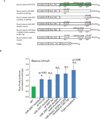microRNAs regulate β-catenin of the Wnt signaling pathway in early sea urchin development
- PMID: 25614238
- PMCID: PMC4433612
- DOI: 10.1016/j.ydbio.2015.01.008
microRNAs regulate β-catenin of the Wnt signaling pathway in early sea urchin development
Abstract
Development of complex multicellular organisms requires careful regulation at both transcriptional and post-transcriptional levels. Post-transcriptional gene regulation is in part mediated by a class of non-coding RNAs of 21-25 nucleotides in length known as microRNAs (miRNAs). β-catenin, regulated by the canonical Wnt signaling pathway, has a highly evolutionarily conserved function in patterning early metazoan embryos, in forming the Anterior-Posterior axis, and in establishing the endomesoderm. Using reporter constructs and site-directed mutagenesis, we identified at least three miRNA binding sites within the 3' untranslated region (3'UTR) of the sea urchin β-catenin. Further, blocking these three miRNA binding sites within the β-catenin 3'UTR to prevent regulation of endogenous β-catenin by miRNAs resulted in a minor increase in β-catenin protein accumulation that is sufficient to induce aberrant gut morphology and circumesophageal musculature. These phenotypes are likely the result of increased transcript levels of Wnt responsive endomesodermal regulatory genes. This study demonstrates the importance of miRNA regulation of β-catenin in early development.
Keywords: Circumesophageal muscles; Endoderm; Larval gut; Mesoderm; PMCs; Post-transcriptional regulation; Sea urchin; Target protectors.
Copyright © 2015 Elsevier Inc. All rights reserved.
Figures








Similar articles
-
Nuclear beta-catenin-dependent Wnt8 signaling in vegetal cells of the early sea urchin embryo regulates gastrulation and differentiation of endoderm and mesodermal cell lineages.Genesis. 2004 Jul;39(3):194-205. doi: 10.1002/gene.20045. Genesis. 2004. PMID: 15282746
-
TCF is the nuclear effector of the beta-catenin signal that patterns the sea urchin animal-vegetal axis.Dev Biol. 2000 Jan 15;217(2):230-43. doi: 10.1006/dbio.1999.9551. Dev Biol. 2000. PMID: 10625549
-
LvGroucho and nuclear beta-catenin functionally compete for Tcf binding to influence activation of the endomesoderm gene regulatory network in the sea urchin embryo.Dev Biol. 2005 Mar 1;279(1):252-67. doi: 10.1016/j.ydbio.2004.12.023. Dev Biol. 2005. PMID: 15708573
-
The emergence of pattern in embryogenesis: regulation of beta-catenin localization during early sea urchin development.Sci STKE. 2006 Nov 14;2006(361):pe48. doi: 10.1126/stke.3612006pe48. Sci STKE. 2006. PMID: 17106077 Review.
-
[Wnt signaling pathway and the Evo-Devo of deuterostome axis].Yi Chuan. 2011 Jul;33(7):684-94. doi: 10.3724/sp.j.1005.2011.00684. Yi Chuan. 2011. PMID: 22049680 Review. Chinese.
Cited by
-
Roles of β-catenin, TCF-4, and survivin in nasopharyngeal carcinoma: correlation with clinicopathological features and prognostic significance.Cancer Cell Int. 2019 Feb 28;19:48. doi: 10.1186/s12935-019-0764-7. eCollection 2019. Cancer Cell Int. 2019. PMID: 30867651 Free PMC article.
-
Transcription of microRNAs is regulated by developmental signaling pathways and transcription factors.Front Cell Dev Biol. 2024 Apr 24;12:1356589. doi: 10.3389/fcell.2024.1356589. eCollection 2024. Front Cell Dev Biol. 2024. PMID: 38721525 Free PMC article.
-
MicroRNA-497-5p attenuates IL-1β-induced cartilage matrix degradation in chondrocytes via Wnt/β-catenin signal pathway.Int J Clin Exp Pathol. 2019 Aug 1;12(8):3108-3118. eCollection 2019. Int J Clin Exp Pathol. 2019. PMID: 31934153 Free PMC article.
-
microRNA-31 regulates skeletogenesis by direct suppression of Eve and Wnt1.Dev Biol. 2021 Apr;472:98-114. doi: 10.1016/j.ydbio.2021.01.008. Epub 2021 Jan 20. Dev Biol. 2021. PMID: 33484703 Free PMC article.
-
microRNA regulation of Wnt signaling pathways in development and disease.Cell Signal. 2015 Jul;27(7):1380-91. doi: 10.1016/j.cellsig.2015.03.018. Epub 2015 Apr 2. Cell Signal. 2015. PMID: 25843779 Free PMC article. Review.
References
-
- Aberle H, Schwartz H, Kemler R. Cadherin-catenin complex: protein interactions and their implications for cadherin function. J Cell Biochem. 1996;61:514–523. - PubMed
-
- Anastas JN, Moon RT. WNT signalling pathways as therapeutic targets in cancer. Nat Rev Cancer. 2013;13:11–26. - PubMed
-
- Annunziata R, Perillo M, Andrikou C, Cole AG, Martinez P, Arnone MI. Pattern and process during sea urchin gut morphogenesis: The regulatory landscape. Genesis. 2013 - PubMed
Publication types
MeSH terms
Substances
Grants and funding
LinkOut - more resources
Full Text Sources
Other Literature Sources
Miscellaneous

